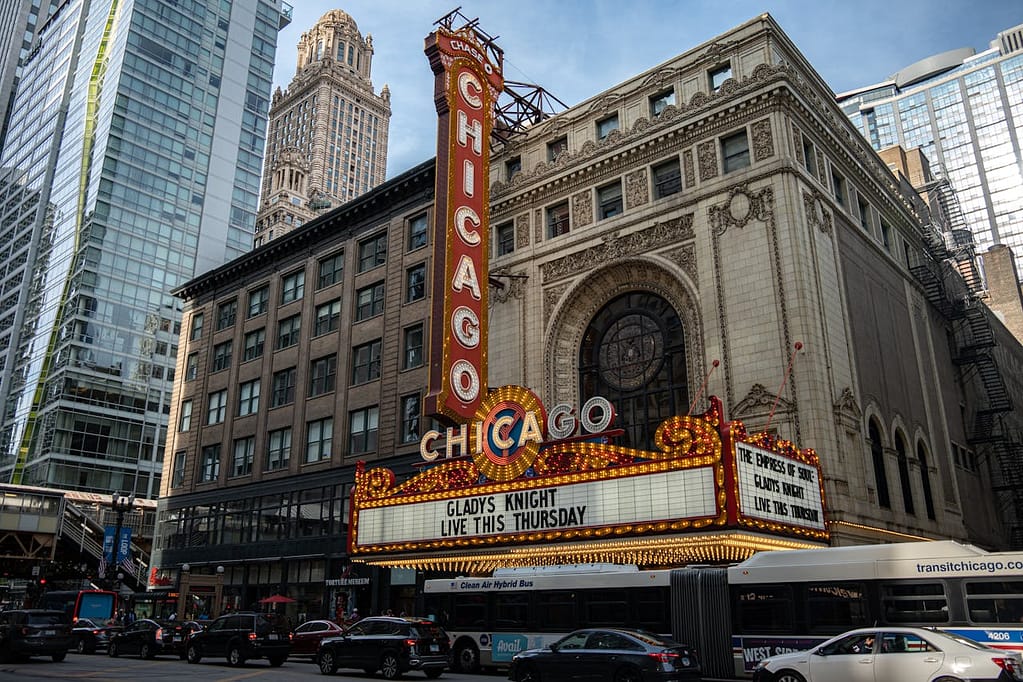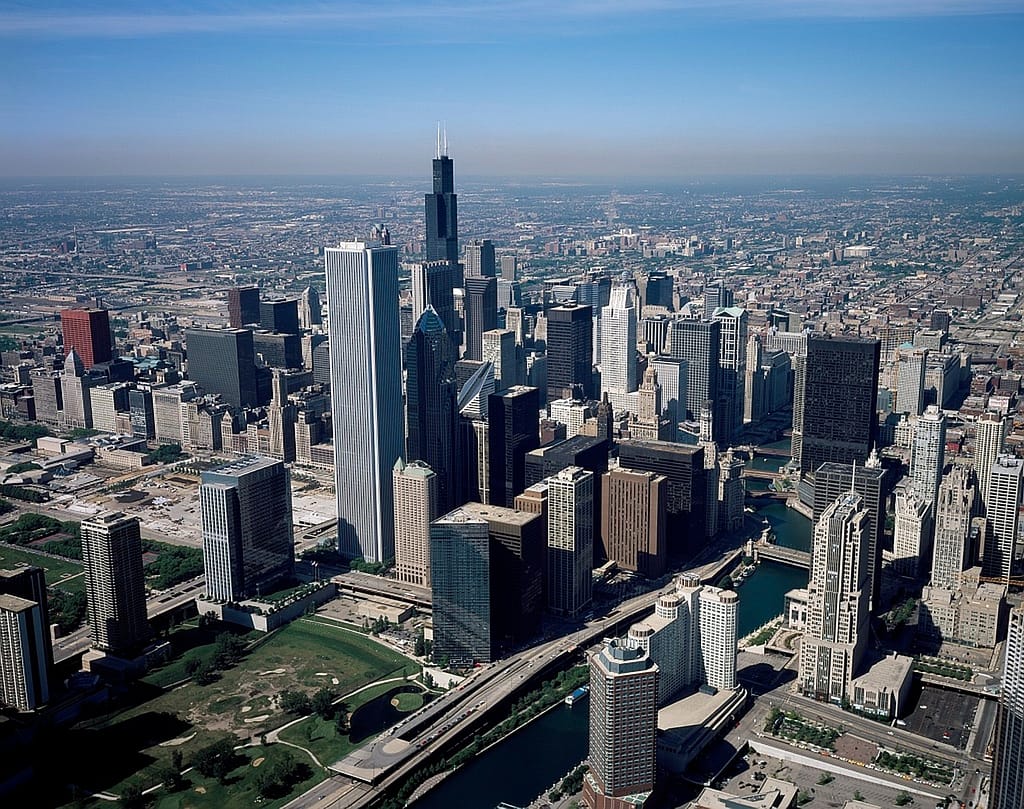
Contents
- 1 Introduction
- 2 Must-See Chicago Landmarks That Define the Windy City
- 3 Top Chicago Museums Worth Exploring in 2025
- 4 Adler Planetarium and Iconic Buildings You Can’t-Miss
- 5 Best Chicago Parks and Outdoor Attractions for Nature Lovers
- 6 Chicago’s Most Interesting Neighborhoods: Local Gems Beyond Downtown
- 7 Must-Try Chicago Food Experiences: Where to Eat Like a Local
- 8 Must-Try Chicago Food Experiences: Where to Eat Like a Local
- 9 Chicago’s Best Entertainment Venues and Nightlife Districts
- 10 Best Things to Do in Chicago Every Season
- 11 Top Chicago Attractions for Kids and Families
- 12 Off-the-Beaten-Path Chicago Attractions Locals Love
- 13 Conclusion
- 14 Additional Elements
Introduction
SOAK UP THE STUNNING CHICAGO SIGHTS Nestled on the fringes of Lake Michigan, Chicago is a breathtaking monument to American ingenuity and cultural diversity. The skyline of the Windy City, dotted with architectural wonders that gave birth to the modern skyscraper, provides a dramatic setting for a city loaded with world-class attractions, exciting neighborhoods, and memorable experiences.
After years of research, miles walked, and asking local experts, we’ve put together this ultimate guide to the best places to visit in Chicago for 2025. Our reviewers have traversed every nook of this vibrant city to make sure you experience Chicago’s one-of-a-kind blend of midwestern charm and cosmopolitan sophistication.
Whether you are drawn to the sparkling surfaces of Cloud Gate or the collections of world-class museums, expansive parks, or signature foods, there is something for every type of traveler in Chicago. This guide includes its landmarks, cultural institutions, architectural marvels, open spaces, neighborhoods, and dining scene that propelled Chicago to the world culinary stage.
Whatever the length of your visit, from a weekend trip to an extended stay, this guide will help you experience the very best of Chicago as if you lived here. Let’s explore the must-have experiences that make this City second to none.
Must-See Chicago Landmarks That Define the Windy City
Chicago’s skyline is instantly recognizable worldwide, but the city’s landmarks offer far more than just photo opportunities. These iconic attractions provide insights into Chicago’s history, culture, and the innovative spirit that continues to define it today.
Cloud Gate (The Bean) at Millennium Park

No visit to Chicago is complete without seeing the reflective wonder known as “The Bean.” Officially named Cloud Gate, this massive stainless steel sculpture by artist Anish Kapoor has become Chicago’s most photographed attraction since its unveiling in 2006.
The 110-ton masterpiece reflects Chicago’s stunning skyline and the changing sky, creating endless photo opportunities. Its seamless mirrored surface invites visitors to interact with the artwork, making it both an artistic landmark and a social gathering spot.
Visitor Information:
- Hours: Open daily, 6 AM-11 PM
- Cost: Free
- Best Time: Early morning for fewer crowds or at sunset for dramatic lighting
- Insider Tip: Visit during weekdays or winter months for the best chance to capture photos without crowds
According to Choose Chicago, over 20 million visitors explore Millennium Park annually, with The Bean serving as the central attraction. This free landmark exemplifies Chicago’s commitment to public art and spaces.
Willis Tower Skydeck
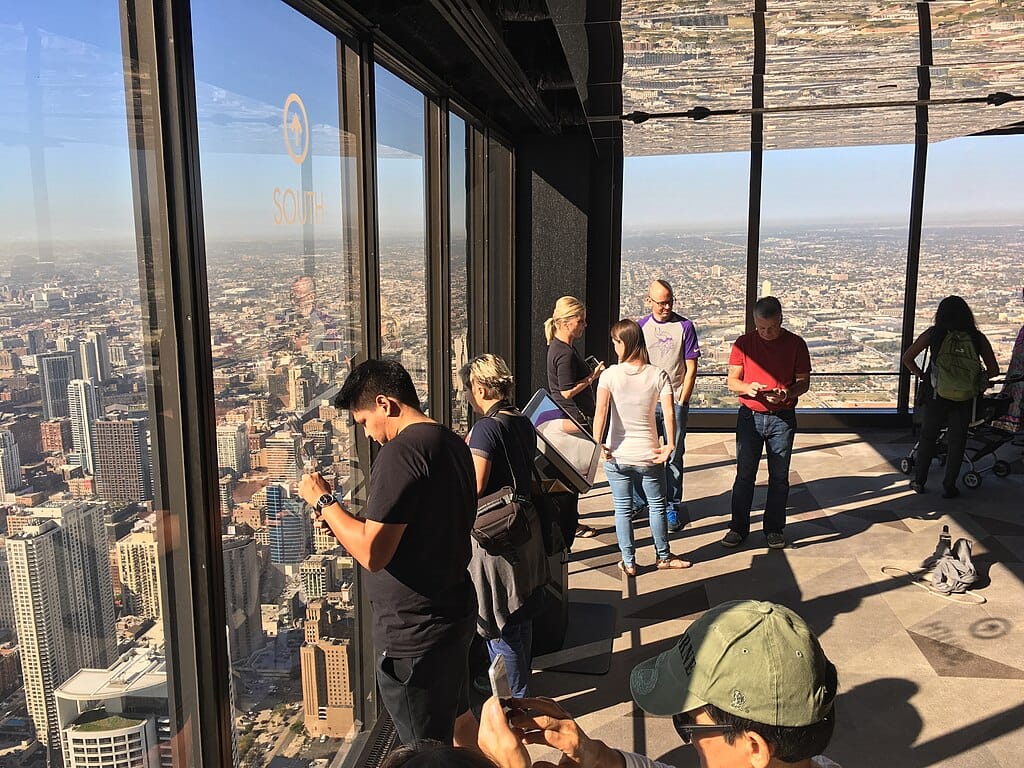
Once the world’s tallest building (and still Chicago’s tallest), the Willis Tower (formerly Sears Tower) offers breathtaking views from 1,353 feet above street level. The main attraction is The Ledge – glass balconies extending 4.3 feet outside the building’s 103rd floor, creating the thrilling sensation of floating above Chicago.
On clear days, visitors can see four states (Illinois, Indiana, Wisconsin, and Michigan) spanning up to 50 miles in each direction. Interactive displays throughout the Skydeck tell the story of Chicago’s architectural innovation and cultural landmarks.
Visitor Information:
- Hours: April-September 9 AM-10 PM, October-March 10 AM-8 PM (last entry 30 minutes before closing)
- Cost: Adults $30-45, Children (3-11) $22-35 (varies by season and time)
- Best Time: 30-60 minutes before sunset to experience both daytime and nighttime views
- Insider Tip: Book tickets online and consider the Fast Pass option during peak tourist season
Recent statistics show over 1.7 million visitors experience the Skydeck annually, making it one of Chicago’s most popular paid attractions.
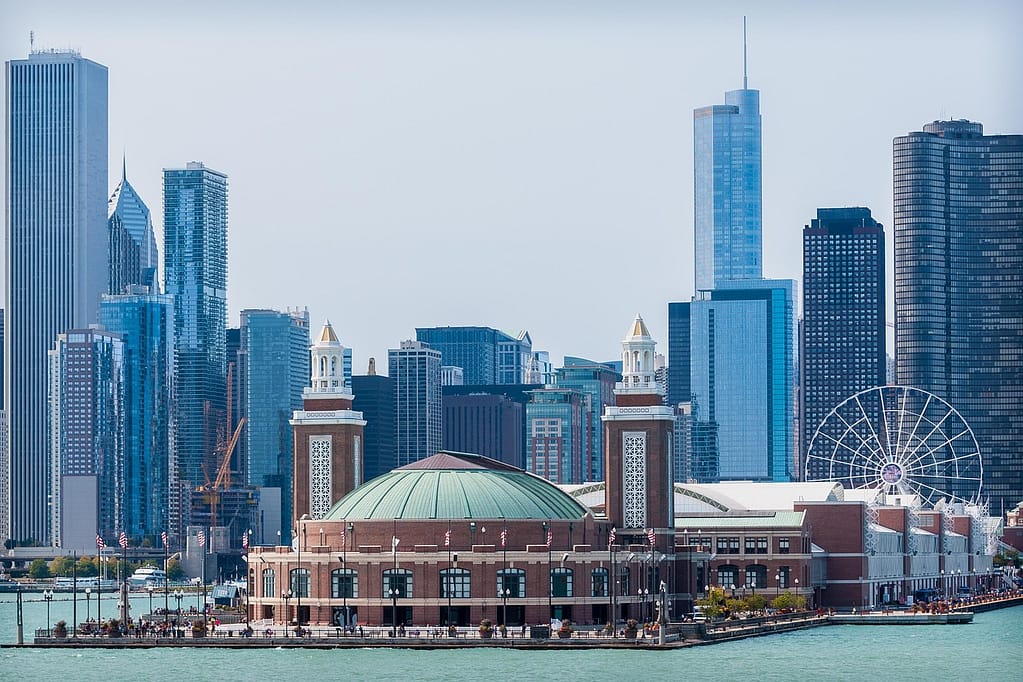
Extending nearly a mile into Lake Michigan, Navy Pier combines entertainment, dining, and cultural attractions in one stunning waterfront location. Originally built in 1916 as a shipping and recreation facility, today’s Navy Pier features parks, gardens, shops, restaurants, and spectacular views.
The Centennial Wheel, a nearly 200-foot-tall Ferris wheel, provides breathtaking views of the city and lake. Other attractions include Chicago Shakespeare Theater, Chicago Children’s Museum, Crystal Gardens, and seasonal fireworks displays.
Visitor Information:
- Hours: Sunday-Thursday 10 AM-8 PM, Friday-Saturday 10 AM-10 PM (seasonal variations apply)
- Cost: Free entry (attractions and rides have separate fees)
- Best Time: Weekday afternoons are less crowded; summer evenings feature fireworks on Wednesday and Saturday
- Insider Tip: Take an architectural boat tour departing from Navy Pier for a dual experience
Navy Pier welcomes over 9 million visitors annually, according to recent tourism data, making it Illinois’ most-visited attraction.
The Magnificent Mile
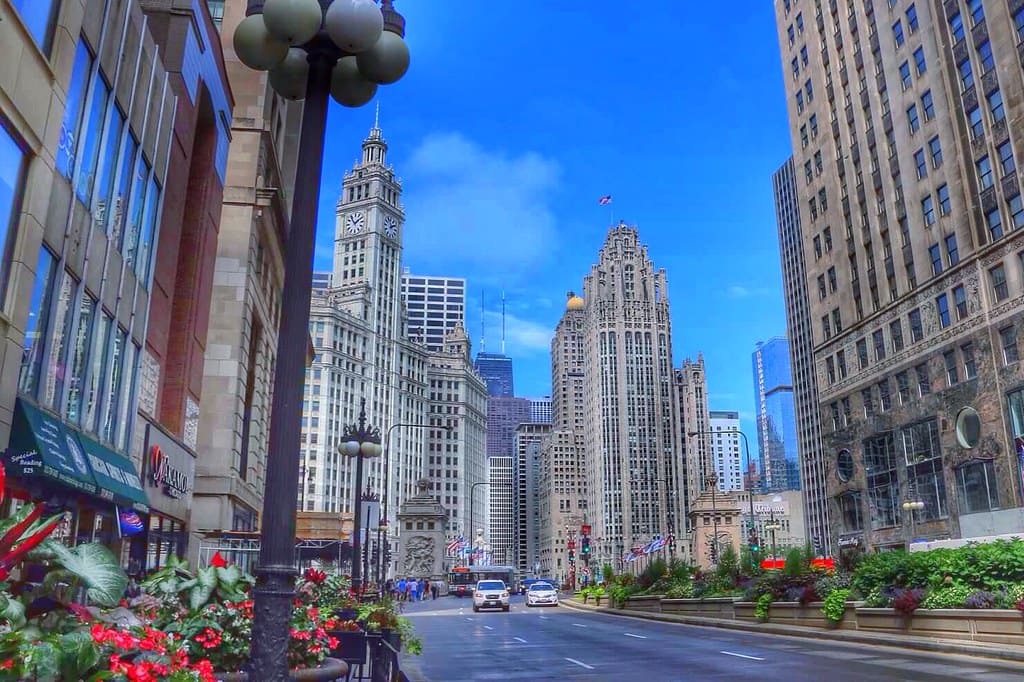
Chicago’s premier commercial district stretches along Michigan Avenue from the Chicago River to Oak Street. This shopper’s paradise features more than 460 retail stores, from luxury flagships to department stores and boutiques, interspersed among historic architecture.
Beyond shopping, The Magnificent Mile includes iconic buildings like the Wrigley Building and Tribune Tower, acclaimed restaurants, luxury hotels, and attractions like 360 CHICAGO (formerly John Hancock Observatory) with its TILT thrill ride.
Visitor Information:
- Hours: Most stores open 10 AM-8 PM Monday-Saturday, 11 AM-6 PM Sunday
- Cost: Free to explore (shopping costs vary)
- Best Time: Weekday mornings for fewer crowds; during the holiday season for spectacular decorations
- Insider Tip: Visit the free Chicago Water Tower, one of the few structures to survive the Great Chicago Fire of 1871
The Magnificent Mile attracts approximately 30 million visitors annually and generates billions in revenue, establishing it as one of North America’s top shopping destinations.
Buckingham Fountain

One of the world’s largest fountains, Buckingham Fountain in Grant Park, is a Chicago landmark inspired by the Latona Fountain at Versailles. Built in 1927, the fountain represents Lake Michigan, with four sets of sea horses symbolizing the four states that border the lake.
During its operational season, the fountain produces a major water display for 20 minutes every hour, with a center jet shooting water 150 feet into the air. At dusk, these displays are accompanied by lights and music, creating a magical atmosphere in Chicago’s “front yard.”
Visitor Information:
- Hours: Operates April to October, 8 AM-11 PM
- Cost: Free
- Best Time: Evening hours for the light and music show
- Insider Tip: Time your visit for the top of the hour to see the major water display
Grant Park, home to Buckingham Fountain, hosts over 20 million visitors annually for various attractions and events, including the famous Taste of Chicago and Lollapalooza music festival.
Top Chicago Museums Worth Exploring in 2025
Chicago hosts some of the nation’s most impressive museums, with collections that rival institutions worldwide. From priceless art to scientific wonders, these cultural powerhouses offer enlightening experiences for visitors of all ages.
Art Institute of Chicago
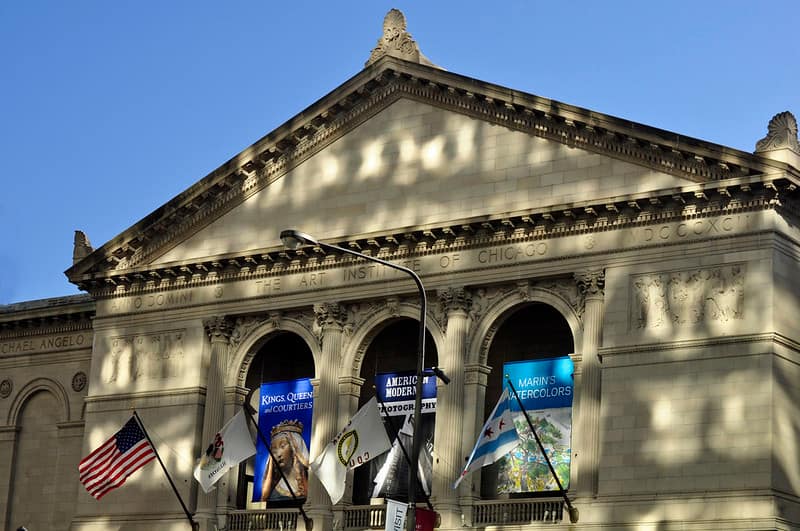
Consistently ranked among the world’s top museums, the Art Institute of Chicago houses more than 300,000 artworks spanning 5,000 years of human expression. The museum’s collection includes iconic pieces like Grant Wood’s “American Gothic,” Edward Hopper’s “Nighthawks,” and Georges Seurat’s “A Sunday on La Grande Jatte.”
The Modern Wing, designed by Renzo Piano, added 264,000 square feet of space to showcase contemporary and modern art. Beyond paintings, visitors can explore photography, textiles, architecture, and extensive collections of Asian, African, and Indigenous American art.
Visitor Information:
- Hours: 11 AM-5 PM daily, Thursday until 8 PM; Closed Tuesdays
- Cost: Adults $25, Chicago residents $19, children under 14 free
- Best Time: Thursday evenings offer a less crowded experience
- Insider Tip: Illinois residents receive free admission on Thursday evenings
In 2024, the Art Institute unveiled its “Reimagining the Collection” initiative, introducing innovative gallery designs and expanding digital access to its vast collections.
Field Museum of Natural History
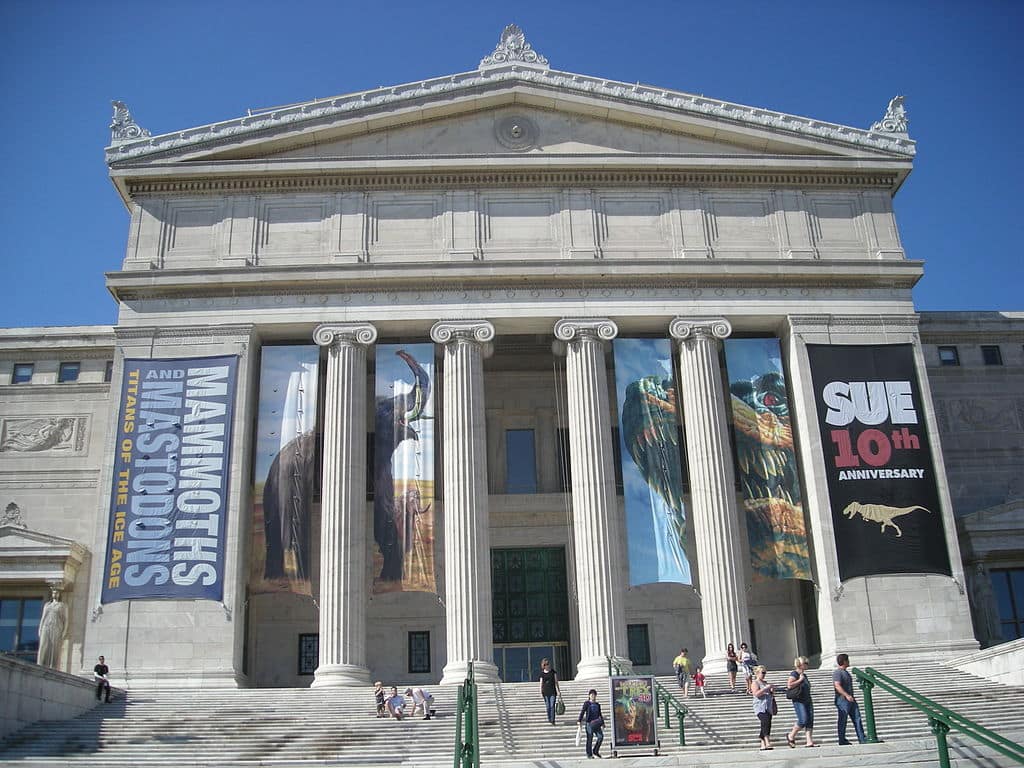
Home to SUE, the most complete Tyrannosaurus rex fossil ever discovered, the Field Museum takes visitors on a journey through natural history. Originally established after the 1893 World’s Columbian Exposition, this institution houses nearly 40 million specimens and artifacts.
Highlights include the comprehensive “Inside Ancient Egypt” exhibition featuring a recreated tomb, “Evolving Planet” tracing 4 billion years of life on Earth, and the “Grainger Hall of Gems” displaying precious stones from around the world.
Visitor Information:
- Hours: 9 AM-5 PM daily (last admission at 4 PM)
- Cost: Basic admission: Adults $27, Children (3-11) $19 (premium exhibitions require additional fees)
- Best Time: Weekday mornings for the smallest crowds
- Insider Tip: The basic ticket doesn’t include special exhibitions; consider the All-Access Pass for a complete experience
The Field Museum’s newest permanent exhibition, “Native Truths: Our Voices, Our Stories,” developed with Native American scholars and community members, provides authentic perspectives on Indigenous experiences.
Museum of Science and Industry

The largest science museum in the Western Hemisphere occupies the former Palace of Fine Arts from the 1893 World’s Columbian Exposition. The Museum of Science and Industry’s interactive approach makes science accessible and exciting through hands-on exhibits and immersive experiences.
Must-see attractions include the U-505 German submarine (the only one captured during WWII), the Coal Mine experience taking visitors down a recreated mine shaft, a massive model railroad, and Science Storms demonstrating natural phenomena.
Visitor Information:
- Hours: 9:30 AM-4 PM daily
- Cost: Adults $21.95, Children (3-11) $12.95
- Best Time: Weekday afternoons tend to be less crowded
- Insider Tip: Some popular exhibits like the U-505 Submarine Tour require separate timed-entry tickets; reserve in advance
For 2025, the museum has expanded its “Future Energy Chicago” exhibit, allowing visitors to design sustainable power solutions for growing urban environments.
Shedd Aquarium
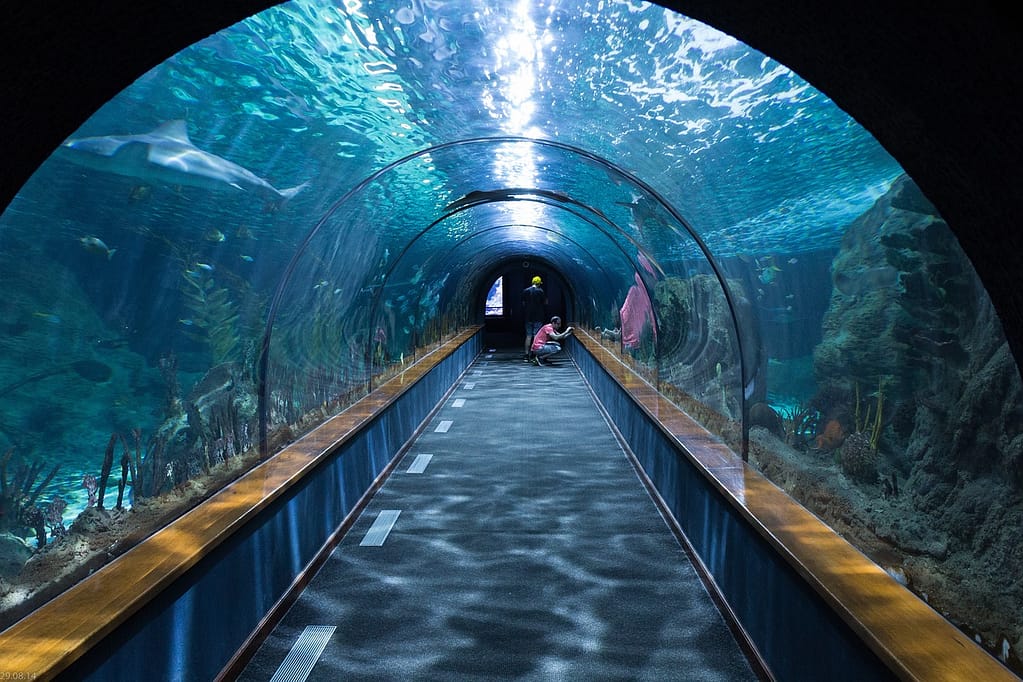
Housing more than 32,000 aquatic animals, Shedd Aquarium combines stunning architecture with world-class marine exhibits. The Caribbean Reef exhibit features a 90,000-gallon circular tank with hundreds of tropical fish, sharks, and a sea turtle, with daily diver presentations.
Other highlights include the Abbott Oceanarium featuring marine mammals like dolphins and beluga whales, Wild Reef’s recreation of a Philippine coral reef, and the Amazon Rising exhibit displaying creatures from the world’s largest rainforest.
Visitor Information:
- Hours: Weekdays 9 AM-5 PM, Weekends 9 AM-6 PM
- Cost: Adults $39.95, Children (3-11) $29.95
- Best Time: Tuesday and Wednesday typically see fewer visitors
- Insider Tip: Purchase tickets online for discounts and to skip long lines
Shedd Aquarium’s conservation initiatives extend globally, with programs focused on Great Lakes restoration, marine mammal rescue, and sustainable seafood advocacy.
Adler Planetarium
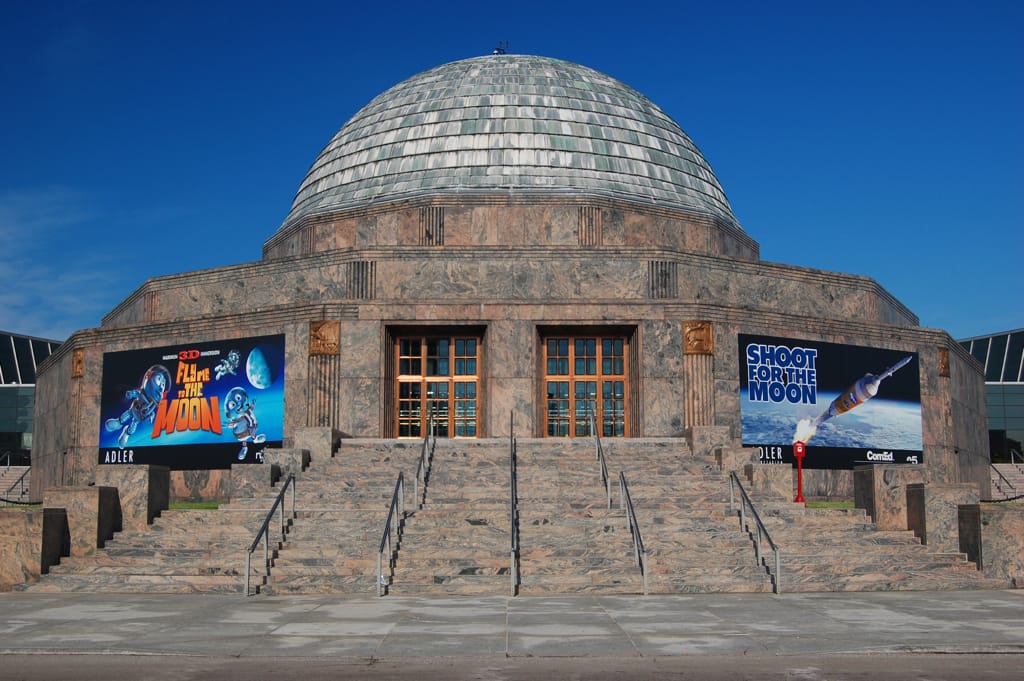
America’s first planetarium continues to inspire visitors with immersive space experiences. Situated on the Museum Campus with stunning skyline views, Adler Planetarium combines historical artifacts with cutting-edge space science through interactive exhibits and three theaters featuring different sky shows.
The museum’s collection includes antique astronomical instruments and the Gemini 12 spacecraft flown by astronaut Jim Lovell. The “Mission Moon” exhibition chronicles America’s lunar exploration, while the “Planet Explorers” area engages younger visitors.
Visitor Information:
- Hours: 9 AM-4 PM daily, closed Tuesdays
- Cost: Adults $19, Children (3-11) $8
- Best Time: The first Monday of each month is free for Illinois residents
- Insider Tip: The outdoor terrace offers one of the best skyline photo opportunities in the city
The Adler Planetarium has introduced “Chicago’s Night Sky” programming for 2025, focusing on urban astronomy and light pollution awareness.
For value-conscious travelers, the Chicago CityPASS provides substantial savings on these attractions. Priced at $114 for adults and $93 for children, the pass includes admission to the Field Museum, Shedd Aquarium, Museum of Science and Industry, and either the Art Institute of Chicago or Adler Planetarium, representing approximately 50% savings over individual tickets.
Adler Planetarium and Iconic Buildings You Can’t-Miss

Recognized worldwide for its architectural innovation, Chicago has shaped the evolution of building design from the invention of the skyscraper to pioneering modernism. The city serves as an open-air museum of architectural history, best experienced through dedicated tours and visits to landmark structures.
Chicago Architecture Center River Cruise

Consistently rated among the city’s top experiences, the Chicago Architecture Center River Cruise provides unparalleled views of the city’s most impressive buildings. Expert docents narrate the 90-minute journey along the Chicago River, explaining the significance of more than 50 architectural landmarks and the city’s pivotal role in developing the modern skyscraper.
Cruises highlight diverse architectural styles from Classical Revival to Art Deco, International Style, and Postmodernism, plus innovative contemporary structures like Jeanne Gang’s undulating Aqua Tower.
Visitor Information:
- Hours: Multiple daily departures from April through November (reduced schedule during winter months)
- Cost: Adults $51-59 (varies by time and date)
- Best Time: The twilight cruise offers magical lighting conditions as buildings transition from daylight to illumination
- Insider Tip: Arrive 30 minutes early for better seating; the port (left) side typically offers the best views
The American Institute of Architects has recognized Chicago as having “the most impressive skyline in America,” with the river cruise providing the perfect vantage point to appreciate this distinction.
Historic Skyscrapers
Chicago birthed the modern skyscraper following the Great Fire of 1871, with innovations like steel-frame construction and the development of the elevator making taller buildings possible. Several pioneering examples remain accessible to visitors:
The Rookery (1888) features an ornate lobby redesigned by Frank Lloyd Wright in 1905. The light court combines iron, marble, and a glass ceiling for spectacular illumination. Guided tours are available Monday-Friday.
Monadnock Building (1891) represents a transition in skyscraper design with its massive load-bearing walls at the base (six feet thick) tapering to just 18 inches at the top. The building houses independent retailers and displays beautiful craftsmanship.
Chicago Board of Trade Building (1930) epitomizes Art Deco grandeur with its limestone facade and distinctive stepped silhouette topped by a three-story statue of Ceres, the goddess of grain. The magnificent lobby is open to visitors during business hours.
Insider Photography Tips: Early morning or late afternoon provide dramatic lighting for architecture photography. For interiors, a wide-angle lens helps capture spacious lobbies, while exterior shots benefit from positioning across the river or in plazas for better perspective.
Frank Lloyd Wright’s Influence

Frank Lloyd Wright, America’s most celebrated architect, began his career in Chicago and left an indelible mark on the region. The Frank Lloyd Wright Trust operates tours of several significant properties:
Robie House (1910) in Hyde Park exemplifies Wright’s revolutionary Prairie School style with its horizontal lines, overhanging eaves, and integration with the landscape. This UNESCO World Heritage site features striking art glass windows and built-in furniture designed by Wright.
Frank Lloyd Wright’s Home and Studio in nearby Oak Park served as Wright’s laboratory for developing his unique architectural voice. The complex restoration allows visitors to experience Wright’s evolving design philosophy firsthand.
Unity Temple, another Oak Park landmark, demonstrates Wright’s innovative use of reinforced concrete and his ability to create transcendent spaces with masterful manipulation of natural light.
Visitor Information:
- Robie House Hours: Thursday-Monday 10 AM-3 PM, closed Tuesday-Wednesday
- Cost: Adults $20, Students/Seniors $17
- Insider Tip: Pre-book guided tours, which provide access to interior spaces not available to walk-in visitors
The American Institute of Architects has named Frank Lloyd Wright “the greatest American architect of all time,” with his Chicago-area works representing his formative and most influential period.
Chicago Cultural Center and Tiffany Dome
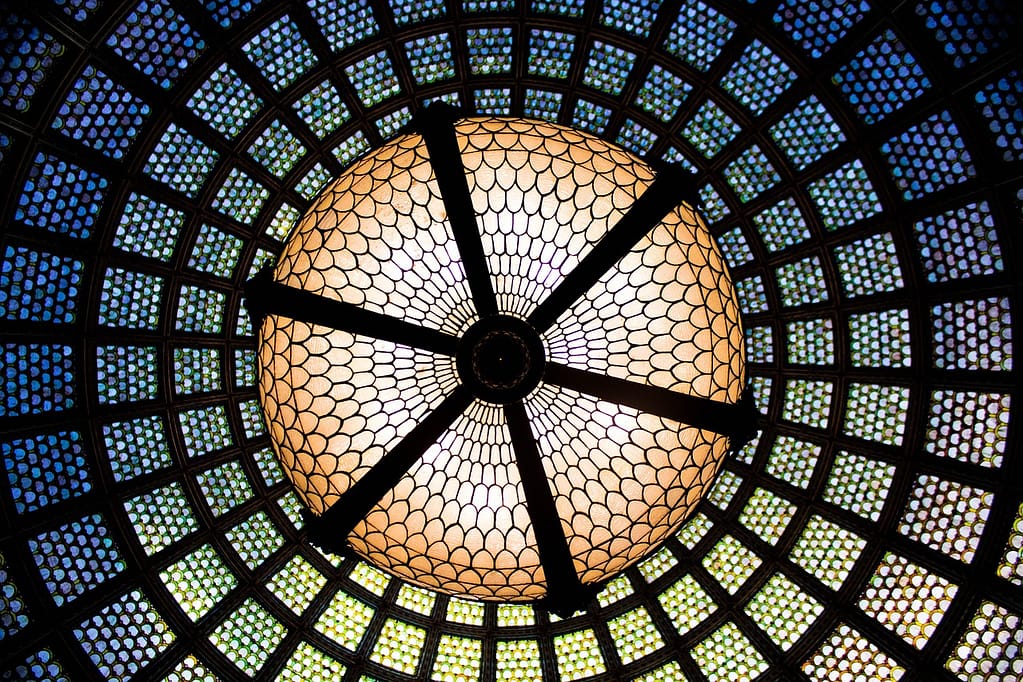
Formerly Chicago’s first public library, this magnificent Beaux-Arts building now hosts free cultural exhibits and events. The Cultural Center’s crown jewel is the world’s largest Tiffany stained glass dome, spanning 38 feet in diameter and containing 30,000 pieces of glass.
The building actually features two stunning domes: the Tiffany dome in Preston Bradley Hall and the equally impressive Renaissance-style dome in Grand Army of the Republic Memorial Hall. The exquisite interiors feature rare marbles, polished brass, and fine hardwoods.
Visitor Information:
- Hours: 10 AM-5 PM daily, closed holidays
- Cost: Free
- Best Time: Midday when sunlight maximizes the domes’ brilliance
- Insider Tip: Free guided tours are available on Wednesdays, Fridays, and Saturdays at 1:15 PM
In addition to its architectural significance, the Cultural Center hosts approximately 1,000 programs and exhibitions annually, making it Chicago’s most comprehensive free cultural venue.
Tribune Tower and Its Embedded Artifacts

This neo-Gothic masterpiece incorporates fragments from famous structures worldwide into its facade. Following an international design competition in 1922, architects John Mead Howells and Raymond Hood created this distinctive tower inspired by French Gothic cathedrals.
The building’s unique feature is over 150 embedded fragments from historic sites including the Great Wall of China, the Taj Mahal, the Parthenon, Notre Dame Cathedral, the Berlin Wall, and even a moon rock. Small plaques identify each artifact’s origin.
Visitor Information:
- Location: 435 N. Michigan Avenue
- Exterior viewing: Accessible anytime (self-guided tours of the embedded fragments)
- Insider Tip: Download the free self-guided tour map available online to locate all artifacts
Although the Tribune Tower has been converted to luxury condominiums, the lobby remains partially accessible and the exterior artifacts can be viewed freely by architecture enthusiasts.
Best Chicago Parks and Outdoor Attractions for Nature Lovers
Despite its urban density, Chicago boasts an impressive 8,800 acres of green space distributed among more than 580 parks. This extensive network provides recreational opportunities, natural beauty, and respite from city life throughout the seasons.
Millennium Park’s Features Beyond The Bean
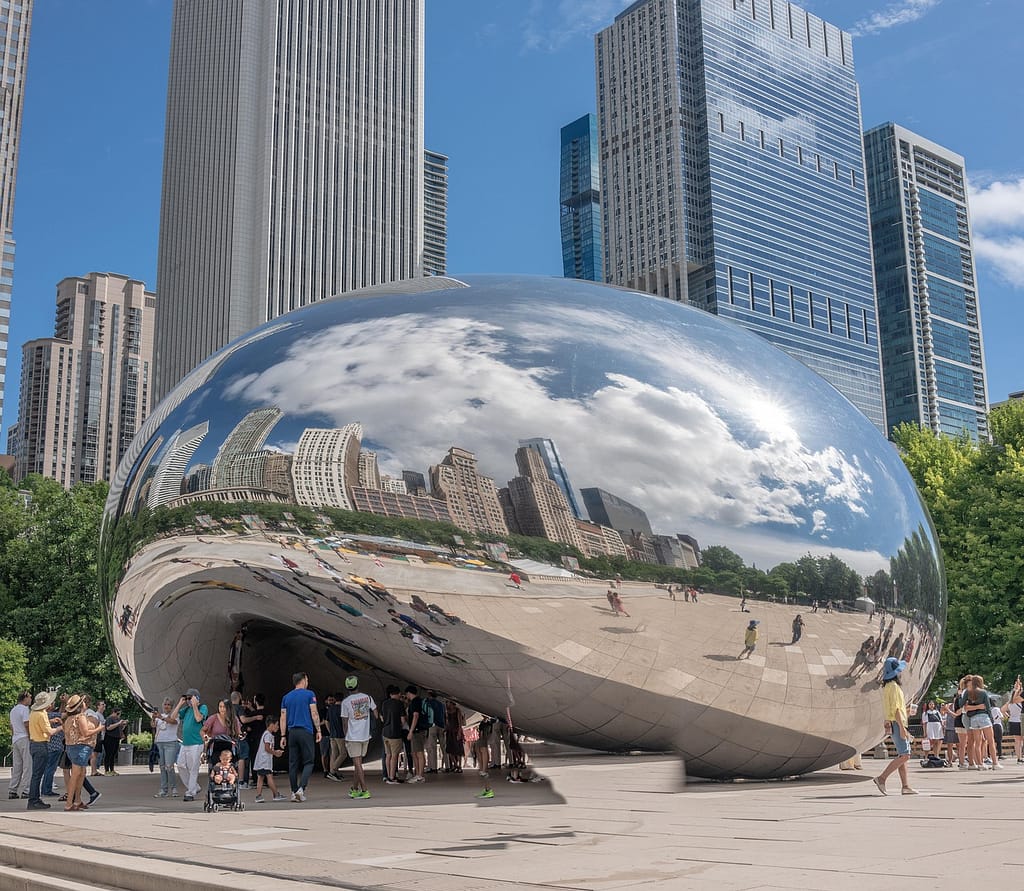
While Cloud Gate attracts the most attention, Millennium Park offers numerous other attractions within its 24.5-acre footprint. The Frank Gehry-designed Jay Pritzker Pavilion hosts free concerts and events during the summer months, with its distinctive metallic headdress and sophisticated sound system creating an optimal outdoor performance venue.
Crown Fountain, designed by Jaume Plensa, features two 50-foot glass block towers displaying rotating faces of Chicago citizens that periodically “spit” water into a reflecting pool, delighting children and photographers alike. Lurie Garden provides a year-round horticultural sanctuary with perennial plantings representing Chicago’s transformation from wild marshland to vibrant city.
Seasonal Highlights:
- Spring: Lurie Garden’s 35,000 perennial plants burst into bloom
- Summer: Free concerts, film screenings, and workout classes
- Fall: Changing foliage creates stunning photo opportunities
- Winter: McCormick Tribune Ice Rink offers skating with a skyline backdrop
According to the Chicago Park District, Millennium Park welcomes approximately 25 million visitors annually, making it one of the most visited public parks in America despite its relatively small size.
Lincoln Park and Free Zoo
Stretching seven miles along Lake Michigan, Lincoln Park is Chicago’s largest public park at 1,200 acres. The park features beautiful gardens, recreational facilities, monuments, and miles of lakefront trails. Its namesake free zoo represents one of the few remaining no-cost, major metropolitan zoos in America.
Lincoln Park Zoo houses over 200 species in naturalistic habitats. Highlights include the Regenstein Center for African Apes, the immersive Pritzker Family Children’s Zoo, and the state-of-the-art Walter Family Arctic Tundra exhibit housing polar bears. The zoo’s conservation efforts extend globally through research and breeding programs for endangered species.
Other park attractions include the Lincoln Park Conservatory with its exotic plant collections, the Chicago History Museum, and the Alfred Caldwell Lily Pool offering a prairie-style landscape design.
Seasonal Recommendations:
- Spring: Witness the Conservatory’s spectacular spring flower show
- Summer: Free concerts at the Zoo’s main lawn
- Fall: Experience spectacular autumn colors throughout the park
- Winter: ZooLights holiday display features over 2.5 million lights
Maggie Daley Park’s Unique Play Areas
Adjacent to Millennium Park, this innovative recreational space revolutionizes the concept of urban playgrounds. The 20-acre park features a 3-acre Play Garden with six distinct play areas based on classic children’s literature like Alice in Wonderland and Charlie and the Chocolate Factory.
The park’s most distinctive feature is the quarter-mile ice skating ribbon that winds through a landscaped terrain. During warmer months, the ribbon converts to a path for walking, jogging, and rollerblading. The park also includes a 40-foot climbing wall, tennis courts, and picnic groves.
Visitor Information:
- Hours: 6 AM-11 PM daily
- Cost: Free entry (climbing wall and equipment rentals have fees)
- Best Time: Weekday mornings for fewer crowds at play areas
- Insider Tip: The skating ribbon requires fewer circles than a traditional rink, creating a more varied experience with changing scenery and elevation
Since opening in 2014, Maggie Daley Park has set new standards for urban park design, winning multiple awards for its innovation in integrating play spaces with public art and landscape architecture.
The 606 Elevated Trail
Following the global trend of converting abandoned rail infrastructure into public space, The 606 transformed the former Bloomingdale Line elevated rail corridor into a 2.7-mile recreational trail and linear park system. Named for Chicago’s zip code prefix, the trail connects four diverse neighborhoods: Wicker Park, Bucktown, Humboldt Park, and Logan Square.
The elevated pathway provides cyclists, runners, walkers, and commuters with an uninterrupted route above street level, complemented by landscaping, public art installations, and gathering spaces. Access points approximately every quarter-mile include ramps and stairs, many featuring distinctive design elements.
Visitor Information:
- Hours: 6 AM-11 PM daily
- Cost: Free
- Best Time: Weekday afternoons for fewer crowds; spring and fall for comfortable temperatures
- Insider Tip: Observatory at Exelon Observatory (Western Avenue access point) offers educational programming about astronomy and environmental monitoring
The 606 has revitalized surrounding neighborhoods while providing much-needed green space to previously underserved communities. According to the Chicago Park District, the trail welcomes over 1.5 million visitors annually.
Lakefront Trail and Beaches
Chicago’s 18-mile Lakefront Trail connects a series of parks, beaches, and attractions along Lake Michigan, offering spectacular views of both the water and the skyline. Popular with cyclists, joggers, and walkers, the paved path provides a scenic recreation corridor serving both tourists and commuters.
The city maintains 26 beaches along Lake Michigan, free and open to the public during the summer months. North Avenue Beach, the most popular, features a beach house resembling an ocean liner and offers equipment rentals and volleyball courts. Other notable beaches include Oak Street Beach with skyline views, 57th Street Beach in Hyde Park, and Montrose Beach with its dog-friendly area.
Seasonal Recommendations:
- Summer: Swimming, sunbathing, and water sports (Memorial Day through Labor Day)
- Fall: Perfect for cycling with fewer crowds and comfortable temperatures
- Winter: Brave locals still use the trail for winter running with proper gear
- Spring: Migratory birds make bird-watching particularly rewarding
Chicago’s commitment to public lakefront access dates back to 1836 when civic leaders declared the lakefront “forever open, clear, and free,” establishing a tradition of public space that continues to define the city.
Chicago’s Most Interesting Neighborhoods: Local Gems Beyond Downtown

While downtown attractions draw the most tourists, Chicago’s distinct neighborhoods reveal the city’s authentic character and diversity. Each community offers unique architecture, cultural experiences, and local flavors that reward exploration beyond typical tourist routes.
Wicker Park/Bucktown’s Hipster Scene
Once working-class communities, Wicker Park and Bucktown have transformed into epicenters of trendy boutiques, independent galleries, music venues, and innovative dining. The six-corner intersection at Milwaukee, Damen, and North Avenues forms the vibrant heart of the district.
The area’s artistic legacy continues with numerous galleries and performance spaces. Vintage and independent retailers line Milwaukee Avenue, while side streets reveal beautifully preserved Victorian-era homes surrounding the actual Wicker Park, a four-acre green space.
Walking Tour Suggestion: Start at the Damen Blue Line station, explore shops along Milwaukee Avenue, browse Myopic Books (one of Chicago’s best independent bookstores), enjoy coffee at local roasters, and visit Piece Brewery for award-winning pizza and beer.
According to Chicago Data Portal demographics, the area attracts primarily younger residents, with 67% of the population between 25-44 years old, supporting its reputation as a hub for creativity and innovation.
Lincoln Park’s Upscale Offerings
Beyond the park itself, the Lincoln Park neighborhood offers tree-lined streets with historic homes, upscale shopping, and refined dining options. The area combines residential charm with cultural attractions and commercial districts.
Armitage Avenue features designer boutiques and home decor shops in beautifully restored Victorian buildings. Halsted Street and Lincoln Avenue provide dining and entertainment options ranging from casual to fine dining establishments, including several Michelin-starred restaurants.
Walking Tour Suggestion: Begin at the historic Biograph Theater (now Victory Gardens Theater), stroll Armitage Avenue’s boutiques, explore residential streets featuring diverse architectural styles, and visit local institutions like Elaine’s Coffee Call in the Hotel Lincoln.
Lincoln Park residents have the highest median household income among Chicago neighborhoods, reflected in the area’s upscale amenities and meticulously maintained historic properties.
Pilsen’s Mexican-American Culture and Murals
Originally settled by Eastern European immigrants, Pilsen transformed into Chicago’s largest Mexican-American community in the mid-20th century. Today, the neighborhood celebrates this cultural heritage through vibrant street art, authentic cuisine, and community events.
Colorful murals adorning buildings throughout Pilsen address themes of identity, immigration, and social justice. The National Museum of Mexican Art houses over 10,000 pieces in the nation’s largest Latino cultural institution. The neighborhood’s commercial corridors feature family-owned restaurants, bakeries, and shops selling traditional goods.
Walking Tour Suggestion: Visit the National Museum of Mexican Art (free admission), photograph murals along 16th Street and 18th Street, explore Thalia Hall (historic theater and music venue), and enjoy authentic regional Mexican cuisine at long-standing establishments.
Pilsen hosts the largest Day of the Dead celebration in the Midwest each November, attracting over 100,000 visitors for processions, altar exhibitions, and related cultural events.
Chinatown’s Authentic Experiences
Chicago’s Chinatown dates to 1912 when Chinese businesses relocated from downtown to the current location south of the Loop. This vibrant community centers around Cermak and Wentworth Avenues, marked by the distinctive Chinatown Gate.
Chinatown Square, a two-level outdoor mall decorated with zodiac animal statues, houses numerous restaurants and shops. Nearby Ping Tom Memorial Park offers riverside relaxation with pagoda-inspired design elements and stunning skyline views. The neighborhood hosts cultural celebrations throughout the year, with Chinese New Year festivities being the largest.
Walking Tour Suggestion: Enter through the ornate Chinatown Gate, browse gift shops along Wentworth Avenue, visit the ornate Pui Tak Center (former immigrant assistance building), explore bakeries for traditional treats, and enjoy authentic regional Chinese cuisine beyond typical American-Chinese offerings.
According to Chicago demographic data, the area maintains a strong cultural identity with 90% of residents identifying as Asian or Asian-American, supporting authentic businesses and traditions.
Hyde Park’s Academic Atmosphere
Home to the University of Chicago, Hyde Park combines intellectual energy with historic architecture and cultural institutions. The neighborhood’s academic influence is evident in its numerous bookstores, cafes, and cultural venues.
The neo-Gothic University of Chicago campus features buildings resembling medieval European universities. The Oriental Institute Museum houses a world-renowned collection of ancient Middle Eastern artifacts. Frank Lloyd Wright’s Robie House exemplifies Prairie School architecture, while the Museum of Science and Industry anchors the northern edge of the neighborhood.
Walking Tour Suggestion: Explore the university’s main quadrangles, visit Robie House, browse the Seminary Co-op Bookstore (one of the world’s premier academic bookstores), walk through Jackson Park (site of the 1893 World’s Columbian Exposition), and discover international dining options reflecting the diverse university community.
Hyde Park’s demographic profile reflects its academic character, with residents holding advanced degrees at twice the city average and representing diverse international backgrounds connected to the university.
Must-Try Chicago Food Experiences: Where to Eat Like a Local

Chicago’s culinary reputation extends far beyond deep-dish pizza, embracing diverse influences from immigrant communities while pioneering distinctive local specialties. From casual classics to fine dining innovations, the city offers unforgettable food experiences at every price point.
Deep Dish Pizza Spots Comparison
Chicago’s signature contribution to world pizza culture features a buttery crust, forming a deep “dish” filled with layers of mozzarella, toppings, and tomato sauce on top. Several legendary establishments claim to have perfected this iconic style:
Lou Malnati’s emphasizes its butter crust and exclusive sausage blend. Chicagoans debate whether the original location in Lincolnwood or the downtown branches deliver the definitive experience. Their “Lou” pizza with spinach, mushrooms, and sliced tomatoes offers a lighter alternative to meat-heavy options.
Pizzeria Uno claims to have invented the deep dish in 1943, with a distinctive cornmeal crust and chunky tomato sauce. The original River North location often has long waits, though nearby Pizzeria Due (their second location) serves identical pizza with occasionally shorter lines.
Giordano’s specializes in “stuffed” deep dishes with an additional layer of thin crust between the cheese and sauce. Their pizza requires even longer baking times but rewards patience with impressive cheese pulls when sliced.
Pequod’s features a distinctive caramelized cheese crust, where cheese between the dough and pan creates a crunchy, blackened edge that has developed a cult following among locals.
Insider Tip: Deep dish pizzas typically require 45-60 minutes for baking. Order when you first arrive or call ahead to minimize waiting.
Chicago-Style Hot Dog Etiquette
The Chicago-style hot dog combines specific ingredients in a prescribed arrangement that locals consider sacred: an all-beef frankfurter on a poppy seed bun topped with yellow mustard, bright green relish, chopped onions, tomato wedges, a pickle spear, sport peppers, and a sprinkle of celery salt. Asking for ketchup can identify you as an outsider immediately.
Portillo’s offers the quintessential Chicago-style hot dog experience in a retro setting. Their River North location serves tourists, while numerous suburban branches cater to locals. Beyond hot dogs, their Italian beef and chocolate cake shakes have loyal followings.
Superdawg features distinctive blue-eyed hot dog characters atop its Northwest Side drive-in. Their “Superdawg” comes wrapped in distinctive blue boxes with creative text. The vintage carhop service creates a nostalgic experience worth the journey outside tourist areas.
The Wieners Circle in Lincoln Park becomes a late-night institution where employees and customers engage in ritualistic insulting banter, particularly after midnight. Their char-grilled dogs have a distinctive flavor from the open-flame cooking method.
Gene & Jude’s in suburban River Grove offers a minimalist approach: hot dogs with just mustard, relish, onions, sport peppers, and hand-cut fries served directly on top of the dog—no tomatoes, no pickles, and absolutely no ketchup.
Insider Tip: Chicago dogs are designed to combine sweet, salty, spicy, and tangy in one perfect bite. Try it with all traditional toppings before customizing.
Italian Beef Sandwiches
This Chicago creation features thin-sliced roast beef slowly simmered in herbed broth, piled on Italian bread, and typically topped with giardiniera (spicy pickled vegetable mix) or sweet peppers. The sandwich can be ordered “dry” (minimal juice), “wet” (extra juice), or “dipped” (entire sandwich briefly submerged in juice).
Al’s #1 Italian Beef dates to 1938 and distinguishes itself with finely sliced beef and a distinctive spice blend. Their Italian-French bread stands up well to the juices, while their hot giardiniera provides significant heat.
Johnnie’s Beef in suburban Elmwood Park justifies the trip for many Chicagoans who consider it the definitive version. Their beef features a cleaner flavor profile with prominent oregano notes, and many customers combine beef and charbroiled Italian sausage into a “combo” sandwich.
Mr. Beef gained additional fame after being the inspiration for “The Bear” television series. Their Italian beef features slightly thicker slices and robust flavor, complemented by a particularly good sweet pepper option.
Price Range: Italian beef sandwiches typically cost $7-11, depending on location and toppings.
Ethnic Neighborhoods for Authentic Cuisine
Chicago’s diverse immigrant history has created distinct food corridors offering authentic international cuisine:
Devon Avenue (West Ridge) features the largest concentration of Indian and Pakistani restaurants in the Midwest. Sabri Nihari specializes in slow-cooked meat dishes, while Mysore Woodlands offers vegetarian South Indian specialties.
Argyle Street (Uptown) is known as “Little Vietnam” with excellent pho, banh mi, and Vietnamese coffee. Tank Noodle anchors the district with extensive menu options, while Nha Hang offers regional specialties beyond standard Vietnamese-American fare.
Taylor Street (Little Italy) maintains Italian culinary traditions. Family-owned Tufano’s Vernon Park Tap has served classic dishes since 1930, while Mario’s Italian Lemonade provides seasonal refreshments from a historic stand.
Must-Try Chicago Food Experiences: Where to Eat Like a Local

Ethnic Neighborhoods for Authentic Cuisine (Continued)
Albany Park features one of the most diverse food scenes globally, with Korean, Middle Eastern, Mexican, and Filipino establishments coexisting. Noon O Kabab offers exceptional Persian cuisine, while Jaafer Sweets specializes in Middle Eastern pastries and honey-soaked treats.
Greektown on Halsted Street preserves Greek culinary traditions despite urban development. The Parthenon claims to have invented saganaki (flaming cheese), while Artopolis Bakery offers traditional pastries and breads.
According to recent James Beard Foundation recognitions, Chicago received 13 semifinalist nominations in 2024, demonstrating the city’s continued culinary excellence across diverse cuisines and price points.
Food Halls and Markets for Variety
Chicago’s Food Hall Renaissance offers one-stop culinary exploration with multiple vendors under one roof:
Time Out Market Chicago in Fulton Market curates 18 eateries representing the city’s best chefs and restaurants. Standouts include duck inn dogs, barbecue from Soul & Smoke, and artistic desserts from Pretty Cool Ice Cream.
Chicago French Market near Ogilvie Transportation Center features over 30 vendors selling prepared foods, fresh produce, and specialty ingredients. Perfect for assembling picnics or sampling diverse options from Belgian frites to Vietnamese bánh mì.
Politan Row in the West Loop offers a more intimate food hall experience with carefully selected vendors emphasizing global flavors and craft beverages from its central bar.
Revival Food Hall in the Loop brings together outposts of neighborhood favorites in a restored historic building, making it ideal for business lunches or pre-theater dining.
Chicago currently hosts 12 Michelin-starred restaurants, with Alinea maintaining its three-star rating since the guide’s Chicago debut. For more accessible experiences, 58 establishments received Bib Gourmand recognition for excellent value, showcasing Chicago’s strength across price points.
Chicago’s Best Entertainment Venues and Nightlife Districts
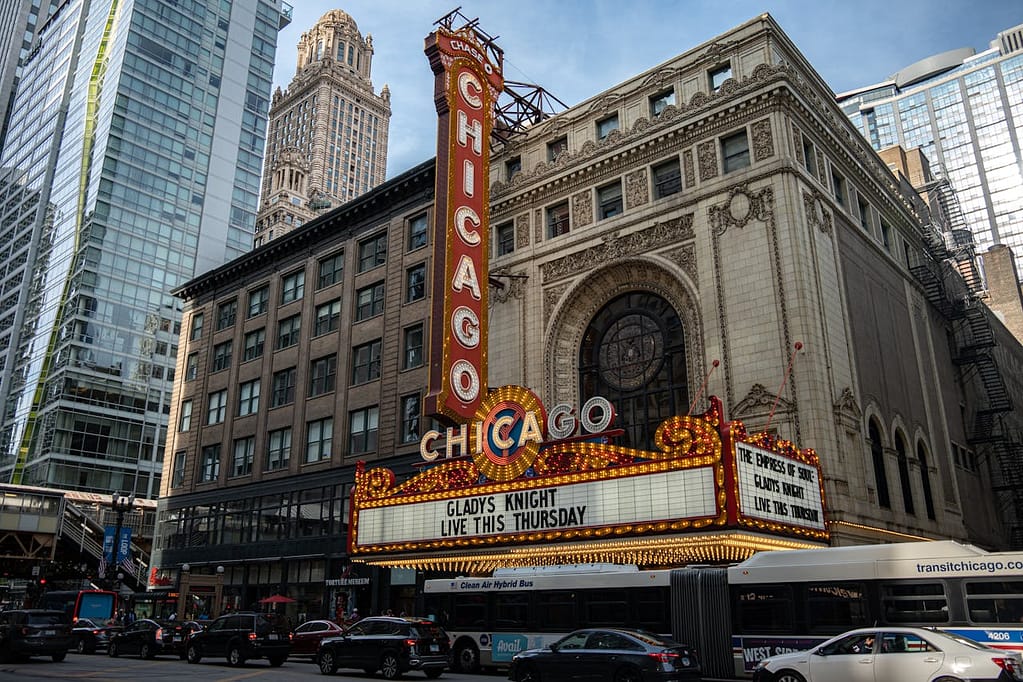
After dark, Chicago’s entertainment options span historic theaters, groundbreaking comedy, legendary music venues, and vibrant nightlife districts. The city’s diverse scenes cater to every taste, from sophisticated cultural experiences to energetic club environments.
Theater District Highlights
Chicago’s Theater District, centered around State Street and Randolph Street, features historic venues hosting Broadway tours, original productions, and world-class performances:
The Chicago Theatre, with its iconic six-story C-H-I-C-A-G-O marquee, began as a lavish movie palace in 1921 and now hosts concerts, comedy, and theatrical events in its meticulously restored French Baroque interior. Behind-the-scenes tours are available daily for $18.
CIBC Theatre (formerly Majestic Theatre) dates to 1906 and serves as the primary venue for Broadway in Chicago productions, including extended runs of hits like Hamilton. The ornate interior features detailed plasterwork and exceptional acoustics.
Cadillac Palace Theatre, after a $25 million restoration, showcases its original 1926 splendor with marble floors, crystal chandeliers, and elaborate ceiling details while hosting major touring productions.
Goodman Theatre, Chicago’s oldest and largest nonprofit theater, produces both classics and groundbreaking new works. Their annual production of “A Christmas Carol” has become a cherished holiday tradition spanning four decades.
Insider Tip for Scoring Tickets: Check Hot Tix booths and website for same-week discounted tickets to many productions. For popular shows, consider weeknight performances for better availability.
According to the League of Chicago Theatres, the city boasts over 250 theater companies producing approximately 1,500 productions annually, making Chicago’s theater scene second only to New York in scale and diversity.
Second City and Comedy Scene
Chicago’s comedy legacy centers around The Second City, the influential comedy theater that launched countless careers from Bill Murray and Tina Fey to Stephen Colbert and Keegan-Michael Key. Founded in 1959, the institution pioneered modern improvisational comedy techniques that transformed American humor.
The Main Stage e.t.c. Theaters present scripted revues developed through improvisation, while the Training Center nurtures new talent. After the main shows, free improvisational sets often feature surprise appearances by famous alumni visiting Chicago.
Beyond Second City, the comedy ecosystem includes:
iO Theater focuses on long-form improvisation with multiple stages featuring diverse formats and styles.
Laugh Factory Chicago presents traditional stand-up comedy with national touring headliners and local talent.
The Annoyance Theatre specializes in edgier, experimental comedy productions and unconventional classes.
ComedySportz offers family-friendly, competitive improv where teams battle for audience approval.
Chicago was named “The Greatest Comedy City in America” by USA Today in 2023, noting its unique ecosystem that allows performers to develop distinctive voices before achieving national recognition.
Jazz and Blues Clubs
Chicago’s musical heritage includes pivotal roles in developing both jazz and blues. Historic venues continue this tradition:
Kingston Mines, Chicago’s largest and oldest continuously operating blues club, features two stages with different acts performing simultaneously, allowing patrons to move between rooms for different blues styles. The kitchen serves Southern-inspired comfort food into the early morning hours.
Green Mill Cocktail Lounge maintained its Prohibition-era atmosphere when it was a favorite of Al Capone. The historic jazz club hosts traditional jazz and big bands in an authentic speakeasy setting complete with original Art Deco details.
Jazz Showcase, founded in 1947, emphasizes acoustic straight-ahead jazz by preserving bebop and post-bop traditions while hosting both legendary performers and rising stars in an intimate listening room environment.
Buddy Guy’s Legends, owned by the legendary blues guitarist, combines live performances with a museum-like collection of blues memorabilia. Guy himself performs a residency of shows each January.
Rosa’s Lounge offers one of the most authentic West Side Chicago blues experiences in a no-frills setting where music quality takes precedence over ambiance, attracting serious blues enthusiasts.
Chicago’s musical contributions have been recognized globally, with UNESCO designating Chicago a “City of Music” in its Creative Cities Network, acknowledging the ongoing cultural significance of the city’s musical heritage.
Brewery Tours and Craft Beer Scene
Chicago’s craft brewing renaissance has established the city as a major beer destination with over 160 breweries in the metropolitan area. Several offer tours and tasting room experiences:
Revolution Brewing, Illinois’ largest independent brewery, operates a production facility with weekend tours and a separate brewpub in Logan Square featuring experimental small-batch brews alongside their flagship Anti-Hero IPA.
Goose Island’s Fulton Street production facility offers behind-the-scenes tours of their barrel-aging program, including their renowned Bourbon County Stout variants. Their original Clybourn brewpub serves innovative food pairings with exclusive small-batch beers.
Half Acre Beer Company provides tours at their Balmoral facility while operating taprooms at both their Lincoln Avenue and Balmoral locations, featuring fresh beer and distinctive merchandise.
Lagunitas Chicago houses the largest brewery taproom in the city within a massive production facility. Free tours run throughout the week, while the elevated taproom overlooks the brewing operation with live music most evenings.
Motor Row Brewing occupies a historic automobile showroom in the South Loop, preserving architectural details while creating a community gathering space with rotating food vendors.
According to the Illinois Craft Brewers Guild, the state’s craft brewing industry has grown by over 350% in the past decade, with Chicago serving as the epicenter of this expansion.
Rooftop Bars with Skyline Views
Chicago’s dramatic skyline provides the perfect backdrop for elevated drinking experiences:
Cindy’s atop the Chicago Athletic Association Hotel offers panoramic views over Millennium Park and Lake Michigan from its glass-enclosed rooftop restaurant and open-air terrace. Sophisticated cocktails complement the upscale atmosphere.
LH Rooftop at LondonHouse Chicago occupies three levels, culminating in a cupola that represents one of the highest public viewpoints in the city. Classic cocktails receive modern interpretations while overlooking the Chicago River and Michigan Avenue.
The J. Parker above Hotel Lincoln provides views spanning Lincoln Park to the downtown skyline. The retractable roof ensures year-round operation regardless of Chicago’s notoriously unpredictable weather.
Raised at Renaissance Chicago Downtown focuses on local spirits and beer alongside urban garden elements that soften the architectural surroundings.
VU Rooftop Bar in the South Loop offers 360-degree views from the 22nd floor, with firepits extending the outdoor season and creative cocktails featuring unique presentation elements.
According to travel publication Condé Nast Traveler, Chicago ranks among North America’s top cities for elevated dining and drinking experiences, with its rooftop venues playing a significant role in this recognition.
Best Things to Do in Chicago Every Season

Chicago transforms dramatically with the seasons, each offering distinct experiences that showcase different aspects of the city’s character. Understanding seasonal highlights helps visitors maximize their experience regardless of when they visit.
Summer Festivals and Beach Activities
Summer represents Chicago’s most vibrant season, with festivals, outdoor concerts, and lakefront recreation dominating the social calendar:
Taste of Chicago (July) transforms Grant Park into the world’s largest food festival, with restaurants offering sample-sized portions of signature dishes alongside musical performances and cooking demonstrations.
Lollapalooza (August) brings 170+ music acts across eight stages to Grant Park for a four-day festival attracting 400,000 attendees. Beyond music, the event features culinary experiences curated by Chicago chefs.
Chicago Air and Water Show (August) presents spectacular aerial displays along the lakefront, drawing over 2 million spectators to watch military and civilian aircraft performances over Lake Michigan.
Chicago’s 26 beaches officially open from Memorial Day through Labor Day with lifeguards on duty. North Avenue Beach serves as the most popular, with its distinctive beach house and volleyball tournaments, while Montrose Beach offers a more relaxed atmosphere with dedicated dog-friendly areas.
Millennium Park Summer Film Series presents free outdoor movies on a state-of-the-art LED screen every Tuesday evening, while Grant Park Music Festival offers free classical concerts at the Jay Pritzker Pavilion.
Chicagoans maximize outdoor time during summer, with average high temperatures around 84°F (29°C) in July and August.
Fall Foliage and Harvest Events
Autumn brings comfortable temperatures and vibrant colors to Chicago’s extensive parks and tree-lined streets:
Lincoln Park and Jackson Park offer impressive fall foliage displays from late September through October, with Japanese maple, oak, and maple trees providing brilliant reds and golds against the backdrop of the skyline.
Chicago Marathon (October) draws 45,000 runners on a course winding through 29 neighborhoods, accompanied by approximately 1.7 million spectators and numerous community celebration zones.
Open House Chicago (October) provides rare access to over 250 architectural gems not typically open to the public, with sites ranging from historic skyscrapers to private clubs, theaters, and sacred spaces.
Lincoln Park Zoo’s Fall Fest features seasonal activities including pumpkin patches, corn mazes, and harvest-themed entertainment within the free zoo grounds.
Northalsted Halloween Parade showcases elaborate costumes and floats in one of the nation’s largest and most creative Halloween processions.
Fall temperatures gradually decrease from the pleasant 70s°F (21-26°C) in September to the cooler 50s°F (10-15°C) by November, typically with reduced precipitation and humidity compared to summer.
Winter Holiday Markets and Activities
Chicago embraces winter with distinctive seasonal traditions that transform the urban landscape:
Christkindlmarket (November-December) recreates a traditional German holiday market in Daley Plaza, with wooden chalets selling European ornaments, gifts, and food specialties. The souvenir mugs change design annually and become collectors’ items.
ZooLights at Lincoln Park Zoo illuminates the grounds with over 2.5 million lights arranged in themed displays. Free on Mondays and more affordable than similar displays nationwide, the event includes ice carving demonstrations and seasonal treats.
Maggie Daley Ice Skating Ribbon offers a quarter-mile path winding through landscaped terrain, providing a more interesting experience than traditional rinks. Evening skating with the illuminated skyline creates particularly magical moments.
Macy’s Holiday Windows and Great Tree continue Marshall Field’s traditions with elaborately decorated windows along State Street and a massive Christmas tree in the historic Walnut Room restaurant.
Navy Pier Winter WonderFest brings indoor carnival rides, giant slides, ice skating, and holiday-themed activities to the Chicago landmark, providing weather-protected entertainment during harsh winter months.
Chicago winters typically include temperatures between 25-35°F (-4 to 2°C) from December through February, with periodic snowfall enhancing the seasonal atmosphere but occasionally complicating travel.
Spring Blooms and Celebrations
Spring brings renewed energy to Chicago with cultural celebrations and natural beauty:
Chicago Flower & Garden Show (March) at Navy Pier showcases elaborate garden displays, horticultural competitions, and educational programming about sustainable urban gardening.
St. Patrick’s Day celebrations (March) include the famous dyeing of the Chicago River an emerald green (using environmentally safe vegetable dye) followed by a massive downtown parade and neighborhood celebrations, particularly in Beverly and South Side Irish communities.
Lincoln Park Conservatory Spring Flower Show presents elaborate themed displays in the historic glass house, providing a tropical escape during the variable spring weather.
Chicago Riverwalk reopening brings dining, tour boats, and public art back to the promenade after winter closures, typically with special events celebrating the new season.
Chicago Cubs Opening Day at Wrigley Field signals spring’s arrival for many Chicagoans, regardless of actual weather conditions, with traditions dating back over a century at the historic ballpark.
Spring temperatures gradually rise from the 40s°F (4-9°C) in March to the pleasant 60s°F (15-20°C) by May, though Chicago’s “spring” can feature dramatic temperature swings and occasional late-season snowfall.
Annual events draw approximately 86 million visitors to Chicago annually according to Choose Chicago, with seasonal festivals accounting for a significant portion of tourism activity.
Top Chicago Attractions for Kids and Families
Chicago excels at entertaining younger visitors with interactive museums, expansive parks, and family-friendly attractions that engage children while simultaneously interesting adults.

Navy Pier combines numerous family attractions in one convenient location:
Chicago Children’s Museum spans three floors with hands-on exhibits encouraging imaginative play and learning. Waterways explores water dynamics through dams and locks, while the Tinkering Lab allows kids to create using real tools and materials. The Dinosaur Expedition lets children become paleontologists, excavating fossils.
Centennial Wheel, a nearly 200-foot-tall Ferris wheel, offers climate-controlled gondolas providing spectacular views in all weather conditions. The gentle ride accommodates all ages while delivering unmatched vistas of the lakefront and skyline.
Chicago Shakespeare Theater frequently presents family-friendly productions adapted specifically for younger audiences, with abbreviated running times and engaging staging that serves as an ideal introduction to live performance.
Amazing Chicago’s Funhouse Maze challenges families to navigate through 4,000 square feet of tunnels, mirrors, and obstacles to find the exit.
Polk Bros Park provides free seasonal programming, including movies, concerts, and fitness classes appropriate for families, adjacent to the interactive fountain where children can cool off during summer months.
Family-Friendly Dining Tip: Giordano’s Navy Pier location offers a dedicated children’s menu and entertainment packs to occupy kids during the long wait for deep-dish pizza cooking.
Lincoln Park Zoo’s Free Exhibits
One of the nation’s oldest zoos (established in 1868) maintains free admission while delivering world-class animal exhibits and education:
Regenstein Center for African Apes provides immersive viewing of gorilla and chimpanzee family groups through floor-to-ceiling windows and multiple vantage points designed to observe natural behaviors.
Kovler Lion House underwent a complete renovation to create naturalistic habitats for big cats with improved viewing areas that allow children to get remarkably close to lions, tigers, and other felines.
Farm-in-the-Zoo lets urban children connect with domestic animals through demonstrations of milking, egg collection, and other agricultural activities with hands-on opportunities.
Pritzker Family Children’s Zoo integrates North American wildlife exhibits with play areas designed to mimic animal movements, allowing children to experience jumping like a frog or building like a beaver.
Hope B. McCormick Swan Pond dates to the zoo’s Victorian origins while continuing to delight modern visitors with accessible viewing of graceful waterfowl in a picturesque setting.
Family-Friendly Dining Tip: The Patio at Café Brauer overlooks a scenic pond with natural wildlife while offering a children’s menu with healthier options than typical zoo fare.
Maggie Daley Park’s Play Garden
This innovative play space reimagines traditional playground concepts with interconnected play spaces based on literature and fantasy:
Sea’s Spray provides water features and boat-like structures for imaginative nautical play.
The Harbor includes a massive suspension bridge and lighthouse-inspired structures for climbing and exploration.
The Watering Hole features animal sculptures and climbing equipment inspired by African wildlife.
The Enchanted Forest offers climbing opportunities through whimsical tree houses connected by bridges and slides.
Slide Crater incorporates slides of various heights and types built into a manufactured hillside.
Tower Playground resembles medieval towers with climbing walls, spiral slides, and lookout platforms.
Family-Friendly Dining Tip: Park Grill in adjacent Millennium Park offers a children’s menu with outdoor seating overlooking the ice skating rink during winter months.
Shedd Aquarium’s Interactive Experiences
Beyond passive viewing, Shedd Aquarium incorporates numerous opportunities for children to engage with aquatic environments:
Caribbean Reef features daily diver presentations where marine biologists communicate with audiences from inside the 90,000-gallon circular tank while feeding creatures and answering questions.
Polar Play Zone lets children try on penguin costumes, explore submarine-themed play equipment, and touch starfish and sea urchins in supervised touch pools.
Stingray Touch (seasonal) allows visitors to gently touch stingrays as they glide through a shallow habitat, with educators explaining the animals’ adaptations and behaviors.
Wild Reef recreates a Philippine coral environment where visitors can look up into schools of fish swimming overhead, creating the sensation of underwater immersion.
Oceanarium showcases marine mammals, including dolphins, beluga whales, and sea otters in naturalistic habitats with multiple underwater viewing areas sized for children.
Family-Friendly Dining Tip: Soundings Café offers kid-friendly options with spectacular lake views, though bringing a picnic lunch to enjoy in the adjacent Museum Campus is more economical for families.
LEGOLAND Discovery Center
Located in suburban Schaumburg, LEGOLAND Discovery Center provides a more manageable alternative to full theme parks, focusing entirely on the beloved building blocks:
MINILAND Chicago recreates the city’s iconic skyline and landmarks using over 1.5 million LEGO bricks, with interactive elements that children can trigger.
Kingdom Quest Laser Ride combines a dark ride adventure with target shooting as families battle trolls and skeletons to rescue a princess.
4D Cinema adds sensory effects like wind, rain, and snow to short LEGO-themed films for an immersive viewing experience.
LEGO Racers: Build & Test encourages children to construct vehicles and test them on ramps with speed measurement.
Master Builder Academy offers instruction from professional LEGO designers during scheduled sessions throughout the day.
Family-Friendly Dining Tip: The center allows re-entry, making it possible to visit the nearby Woodfield Mall food court for more dining options than the limited on-site café.
According to family travel bloggers like Family Vacation Critic, Chicago consistently ranks among the top 10 U.S. destinations for family travel, with its combination of educational attractions, outdoor recreation, and convenient public transportation.
Off-the-Beaten-Path Chicago Attractions Locals Love

Beyond mainstream tourist destinations, Chicago rewards explorers with distinctive experiences that reveal the city’s character through lesser-known attractions favored by residents.
Lesser-Known Museums and Galleries
Chicago hosts numerous specialized museums that attract passionate interest in specific subjects:
International Museum of Surgical Science occupies a magnificent lakefront mansion filled with medical artifacts, early surgical instruments, anatomical models, and art related to medical history. The juxtaposition of a serious academic subject in a Gold Coast mansion creates a uniquely Chicago experience.
American Writers Museum celebrates the influence of American writers through interactive exhibits, original manuscripts, and immersive installations exploring diverse literary traditions. The Word Waterfall art installation provides perfect literary Instagram opportunities.
National Museum of Mexican Art in Pilsen represents the largest Latin cultural organization in the U.S., featuring over 10,000 objects spanning ancient Mesoamerica to contemporary Latino artists. Their annual Day of the Dead exhibition draws visitors from throughout the region.
Intuit: The Center for Intuitive and Outsider Art showcases self-taught artists working outside conventional art traditions, including Henry Darger’s landmark 15,000-page illustrated novel created in isolation in a Chicago apartment.
Oriental Institute Museum at the University of Chicago houses one of the world’s most important collections of ancient Middle Eastern artifacts, including significant Assyrian and Egyptian pieces from pioneering archaeological expeditions.
As local journalist Mike Stephen of “Outside the Loop Radio” notes, “These specialized museums reflect passionate Chicago obsessions that might seem eccentric elsewhere but find enthusiastic support here.”
Secret Viewpoints for Photography
Professional photographers and locals favor these alternate vantage points for capturing Chicago’s iconic skyline:
Adler Planetarium peninsula provides the classic postcard view of Chicago’s skyline across the harbor, particularly stunning at sunrise when light illuminates the buildings from the east.
Ping Tom Memorial Park in Chinatown offers unique skyline views framed by the Chicago River in the foreground, away from tourist crowds, and particularly beautiful during sunset.
Promontory Point in Hyde Park juts into Lake Michigan, providing southern views of the skyline that capture the entire linear spread of buildings from an unusual angle.
Milton Lee Olive Park near Navy Pier offers direct skyline views with fewer crowds than nearby tourist areas, with five circular pools providing interesting foreground elements.
Kinzie Street Railroad Bridge provides urban industrial foreground elements framing the skyline from the North Branch of the Chicago River, perfect for photographers seeking grittier compositional elements.
According to Chicago-based photographer Nick Ulivieri, “The city’s most interesting architectural photos come from unexpected vantage points that reveal relationships between buildings invisible from conventional viewpoints.”
Authentic Neighborhood Eateries
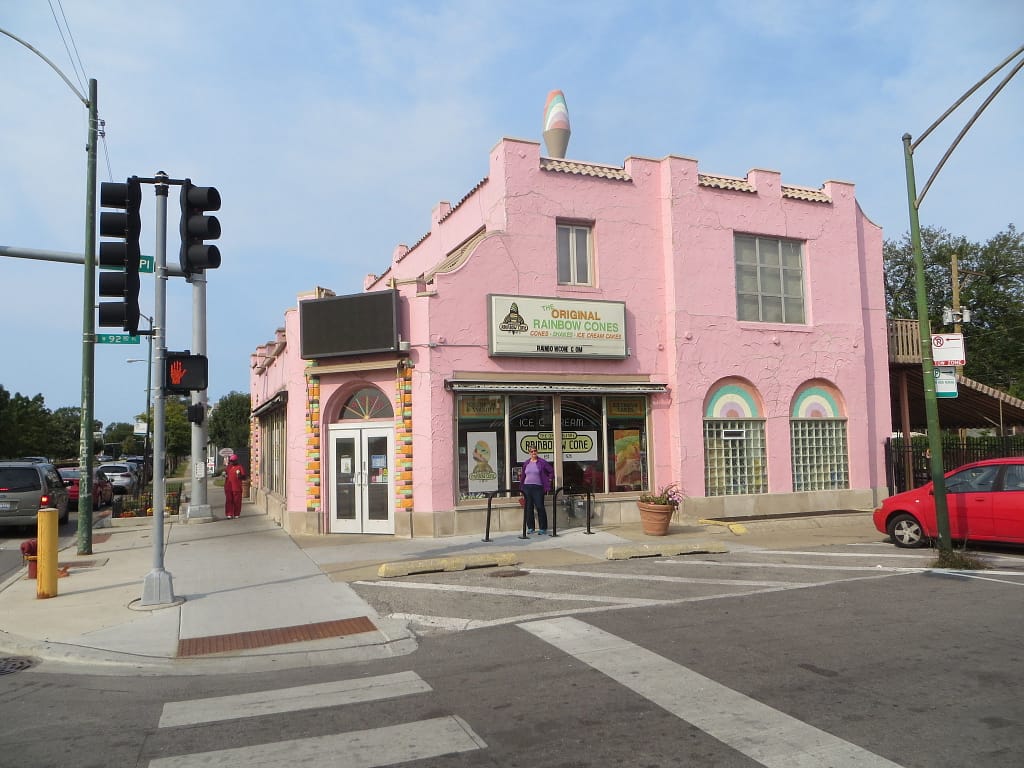
Venturing beyond downtown reveals beloved local institutions serving distinctive Chicago food experiences:
Calumet Fisheries on the far South Side has smoked fish on-site since 1948 using traditional oak wood methods. The cash-only establishment offers smoked shrimp, salmon, and trout for takeout only (no seating), often consumed on the adjacent 95th Street Bridge featured in “The Blues Brothers” film.
Valois in Hyde Park advertises “See Your Food” as cashiers call orders to cooks working in full view. The cafeteria-style restaurant famously displays “President Obama’s Favorites” menu section highlighting his regular breakfast orders from when he lived nearby.
Ricobene’s breaded steak sandwich features a thin-pounded steak cutlet, breaded, fried, and smothered with sweet tomato sauce on Italian bread. USA Today once named it “the best sandwich in the world,” yet it remains largely unknown to tourists.
Rainbow Cone has served its signature five-flavor ice cream cone since 1926. The distinctive dessert layers chocolate, strawberry, Palmer House (New York vanilla with cherries and walnuts), pistachio, and orange sherbet in a specific order.
Freddy’s Pizza in Cicero operates as part Italian grocery, part deli, and part pizzeria from an unassuming storefront. Their gelato draws devoted followers from throughout the region, particularly during summer months.
As Chicago Reader food critic Mike Sula observes, “Chicago’s food reputation was built in neighborhood kitchens long before fine dining attracted international attention. These places preserve culinary traditions that define authentic Chicago experiences.”
Architectural Oddities
Beyond celebrated landmark buildings, Chicago contains whimsical and unusual structures that delight those who discover them:
The Shit Fountain in Ukrainian Village represents sculptor Jerzy Kenar’s artistic protest against dog owners who don’t clean up after their pets. The small bronze coil mounted on a pedestal has become a beloved neighborhood conversation piece.
Henry Darger Room Collection at Intuit Museum meticulously preserves the actual room where the janitor-artist created his 15,000-page illustrated epic “The Story of the Vivian Girls” in secret during the mid-20th century.
The Wrigley Building’s dedicated “Make-up Room” dates from the 1920s when proper ladies would check their appearance after crossing the windy Michigan Avenue Bridge. The small mirrored space maintains its original purpose despite nearly a century of changing social norms.
Oz Park in Lincoln Park features sculptures of characters from “The Wonderful Wizard of Oz,” honoring author L. Frank Baum’s time living in Chicago. The whimsical sculptures include the Tin Man, Scarecrow, Cowardly Lion, and Dorothy with Toto.
Garfield Park Conservatory’s Fern Room contains artificial stone formations designed in 1906 by renowned landscape architect Jens Jensen to recreate the prehistoric Illinois landscape as it appeared a million years ago when ferns dominated the region.
According to architectural historian Tim Samuelson, “These quirky spaces reveal Chicago’s character more authentically than many famous buildings because they emerged from genuine local personalities rather than institutional planning.”
Local Markets and Shopping
Beyond mainstream commercial districts, these distinctive shopping destinations showcase Chicago’s creative entrepreneurs and artisans:
Maxwell Street Market continues a tradition dating to the late 19th century when immigrant entrepreneurs sold goods from pushcarts. The Sunday-only market now features Mexican street food, handcrafted items, vintage goods, and live blues performances.
Randolph Street Market transforms a West Loop venue into a curated vintage and antique marketplace during monthly weekend events. Over 300 vendors sell everything from midcentury furniture to vintage clothing, with food vendors and live music creating a festival atmosphere.
One-of-a-kind Show at Merchandise Mart showcases over 600 independent artists and makers during biannual events featuring handcrafted jewelry, clothing, furniture, and artwork unavailable through conventional retail channels.
Pilsen Community Books combines carefully selected new and used titles with community programming in a neighborhood-focused independent bookstore that has become a cultural anchor for the area.
Plant Shop Chicago specializes in uncommon houseplants displayed in a gallery-like setting in Wicker Park, with staff providing detailed care information and classes for urban plant enthusiasts.
According to local publication Newcity, “Chicago’s independent retailers have survived chain store expansion by creating distinctive shopping experiences that reflect specific community interests and build loyal neighborhood followings.”
Conclusion
Chicago represents a crossroads of cultures, industries, and ideas through its past and the present. It is home to innovative architecture, culinary arts, and traditions that shaped America. The city embraces change while cherishing its identity.
This guide includes some of the most popular premier attractions while also introducing some off-the-beaten-path emerging hotspots, showcasing Chicago’s unique transformation. Exploring most of the places of interest, such as all the landmarks, will reward travelers with different facets of urban life, and Chicago’s neighborhoods have their own unique way of depicting it.
While the city has numerous iconic attractions every traveler should visit, I advise exploring the neighborhoods Chicago is known for. A trip to the city will be best enjoyed by blending architectural landmarks and local culinary joints, cultural institutions, and hidden gems, creating an authentic Chicago feel. Public transport is the best in the cit,y which makes navigating easy even for those new to the city.
For further ease, check out the Chicago Explorer Pass for flexible entry to several attractions or the Chicago CityPASS for access to major museums and observation decks. These and other similar options allow for huge savings while maximizing paid attractions.
While you admire its architectural buildings, take in the artistry of its artistic institutions and remarkable food, or simply just enjoy the lively areas of the city. Chicago’s attractions not only attract eager tourists, but also make travelers understand why the locals are so fond of the city and everything it has to offer.
Which attraction interests you the most? Feel free to share your answer in the comments section!
Additional Elements
Transportation Tips
From O’Hare Airport: The Blue Line ‘L’ train provides direct access to downtown in approximately 45 minutes for $5, compared to $40+ for taxi service.
From Midway Airport: The Orange Line ‘L’ train connects to downtown in approximately 25 minutes for $5.
Within the city: The comprehensive CTA system includes:
- 8 ‘L’ train lines identified by colors
- 129 bus routes serving neighborhoods beyond train lines
- Unlimited ride passes are available for 1-day ($10), 3-day ($20), and 7-day ($28) periods
Water Taxi: Provides scenic transportation along the Chicago River and to the Museum Campus during summer months, with all-day passes available.
Divvy Bikes: City-wide bike share program with 600+ stations and 6,000+ bikes available for single rides ($3.30 per 30 minutes) or day passes ($15).
Accessibility Information
Millennium Park features accessible pathways throughout, with ramp access to Cloud Gate and wheelchair viewing areas at Jay Pritzker Pavilion.
Art Institute of Chicago offers free wheelchair loans, accessible entrances on Michigan Avenue, and tactile tours for visually impaired visitors.
Chicago Cultural Center provides barrier-free access to all galleries and performance spaces via elevators and ramps.
Navy Pier features flat terrain throughout with accessible restrooms, Ferris wheel gondolas, and cruise ship boarding.
Chicago Riverwalk includes ramped access points at each block between Lake Shore Drive and Franklin Street.
FAQ Section
What’s the best time of year to visit Chicago? May through September offers pleasant temperatures and outdoor festivals, though summer humidity can be challenging. September and early October provide comfortable temperatures with smaller crowds.
Is Chicago safe for tourists? The main tourist areas downtown, along the lakefront, and in popular neighborhoods maintain a strong police presence and excellent safety records. Like any major city, awareness of surroundings remains important, particularly at night.
How many days should I plan for a Chicago visit? A minimum of three days allows exploration of major attractions, while five days permits deeper neighborhood discovery and cultural experiences.
Do I need a car in Chicago? No—the combination of public transportation, rideshare services, and walkable attractions makes car rental unnecessary for most visitors and potentially problematic given expensive parking ($25-60 daily in downtown garages).
What’s the tipping etiquette in Chicago? Standard tipping follows American customs: 18-20% for restaurant servers, $1-2 per drink for bartenders, $1-2 per bag for hotel bellhops, and 15-20% for taxi drivers.

